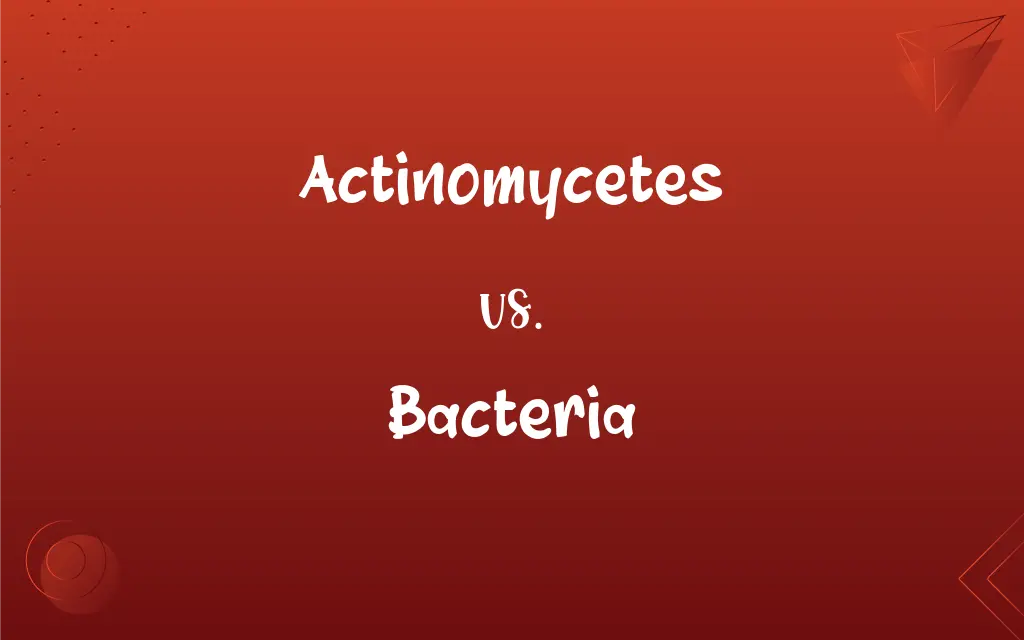Actinomycetes vs. Bacteria: What's the Difference?
Edited by Janet White || By Harlon Moss || Updated on October 19, 2023
Actinomycetes are a group of filamentous bacteria, while bacteria are single-celled microorganisms encompassing a vast range of species.

Key Differences
Actinomycetes and bacteria are both microorganisms, but they differ in their structural composition and morphology. Actinomycetes are recognized for their filamentous and branched structure, resembling fungal mycelia, whereas most bacteria exhibit simple shapes like rods, spheres, or spirals.
The distinction between actinomycetes and bacteria isn't solely based on appearance. Actinomycetes, predominantly found in soil, play a crucial role in organic matter decomposition. On the other hand, bacteria, ubiquitous in nature, can be found in various environments, from the human gut to the deep ocean.
Actinomycetes have gained significant attention in the pharmaceutical industry, mainly due to their ability to produce antibiotics. Bacteria, in contrast, have a broader spectrum of functions and associations, with some being pathogenic to humans and others beneficial or neutral.
Genetically, actinomycetes are a subset of bacteria, belonging to the phylum Actinobacteria. This means all actinomycetes are bacteria, but not all bacteria are actinomycetes. The world of bacteria is vast and diverse, comprising various phyla and species, each with its unique characteristics.
Despite their differences, both actinomycetes and bacteria play pivotal roles in ecological processes and human life. While actinomycetes aid in soil health and antibiotic production, bacteria are involved in numerous processes, from nutrient cycling to aiding digestion in the human gut.
ADVERTISEMENT
Comparison Chart
Morphology
Filamentous and branched structure.
Varying shapes: rods, spheres, spirals, etc.
Primary Habitat
Predominantly soil.
Ubiquitous; found in diverse environments.
Association with Humans
Producers of many antibiotics.
Range from pathogenic to beneficial.
Taxonomy
A subset of bacteria (phylum Actinobacteria).
Includes a vast range of species and phyla.
Function
Organic matter decomposition, antibiotic production.
Involved in various processes, from nutrient cycling to human health.
ADVERTISEMENT
Actinomycetes and Bacteria Definitions
Actinomycetes
Filamentous bacteria primarily found in soil.
Actinomycetes play a vital role in decomposing organic matter.
Bacteria
Many are beneficial, aiding in digestion or nitrogen fixation.
Probiotic supplements contain beneficial bacteria to boost gut health.
Actinomycetes
Bacteria known for their branched mycelium-like structure.
Under the microscope, actinomycetes can be mistaken for fungi due to their appearance.
Bacteria
Some are pathogenic, causing diseases in humans and animals.
Certain strains of bacteria are responsible for illnesses like tuberculosis.
Actinomycetes
Members of the phylum Actinobacteria.
Actinomycetes, as part of the Actinobacteria phylum, are distinct from other bacterial groups.
Bacteria
Ubiquitous organisms found in diverse environments.
From hot springs to the human gut, bacteria can be found nearly everywhere.
Actinomycetes
Producers of a significant portion of known antibiotics.
Scientists often study actinomycetes for their medicinal properties.
Bacteria
Lack a defined nucleus and are classified as prokaryotes.
Unlike eukaryotic cells, bacteria do not have a membrane-bound nucleus.
Actinomycetes
Important contributors to soil health and fertility.
Farmers appreciate the presence of actinomycetes in their fields.
Bacteria
Single-celled microorganisms with various shapes and functions.
Bacteria are essential for many ecological and physiological processes.
Actinomycetes
Any of various spore-forming, chiefly filamentous bacteria of the order Actinomycetales that are abundant in soil. Some species produce natural antibiotics, and some are human pathogens.
Bacteria
Plural of bacterium.
Actinomycetes
Plural of actinomycete
Actinomycetes
Branched gram-positive bacteria, often found in soil, some of which are pathogenic for humans and animals.
FAQs
Do all bacteria cause diseases?
No, while some bacteria are pathogenic, many are beneficial or neutral.
Are actinomycetes found only in soil?
While predominantly found in soil, actinomycetes can also be found in other environments.
What are bacteria?
Bacteria are single-celled microorganisms with a vast range of species and functions.
Are actinomycetes considered prokaryotes?
Yes, like all bacteria, actinomycetes are prokaryotes.
Can bacteria be seen with the naked eye?
Individual bacteria are microscopic, but colonies can sometimes be visible.
Why are actinomycetes significant in medicine?
They produce a considerable portion of known antibiotics.
Are all actinomycetes beneficial?
While many have beneficial properties, not all are beneficial.
Can bacteria produce energy without oxygen?
Yes, some bacteria can undergo anaerobic respiration or fermentation.
How do bacteria protect themselves from unfavorable conditions?
Some bacteria form protective structures called endospores to survive adverse conditions.
Are bacteria only harmful to humans?
No, while some bacteria can be harmful, others are essential for human health and various ecological processes.
What distinguishes actinomycetes morphologically from other bacteria?
Actinomycetes have a filamentous and branched structure, resembling fungal mycelia.
How do bacteria reproduce?
Most bacteria reproduce by binary fission, a type of asexual reproduction.
Why are actinomycetes important for soil health?
They play a crucial role in decomposing organic matter.
Can bacteria survive in extreme environments?
Yes, certain bacteria, called extremophiles, thrive in extreme conditions.
What role do actinomycetes play in antibiotic production?
Actinomycetes produce a significant portion of known antibiotics.
Can bacteria be beneficial for human health?
Absolutely, many bacteria are essential for digestion and overall gut health.
Are actinomycetes a type of bacteria?
Yes, actinomycetes are a group of bacteria known for their filamentous structure.
Where are actinomycetes primarily found?
They are predominantly found in soil.
Do bacteria have a nucleus?
Bacteria lack a defined nucleus and are classified as prokaryotes.
Are actinomycetes and fungi the same?
No, though actinomycetes have a filamentous structure similar to fungi, they are bacteria.
About Author
Written by
Harlon MossHarlon is a seasoned quality moderator and accomplished content writer for Difference Wiki. An alumnus of the prestigious University of California, he earned his degree in Computer Science. Leveraging his academic background, Harlon brings a meticulous and informed perspective to his work, ensuring content accuracy and excellence.
Edited by
Janet WhiteJanet White has been an esteemed writer and blogger for Difference Wiki. Holding a Master's degree in Science and Medical Journalism from the prestigious Boston University, she has consistently demonstrated her expertise and passion for her field. When she's not immersed in her work, Janet relishes her time exercising, delving into a good book, and cherishing moments with friends and family.
































































